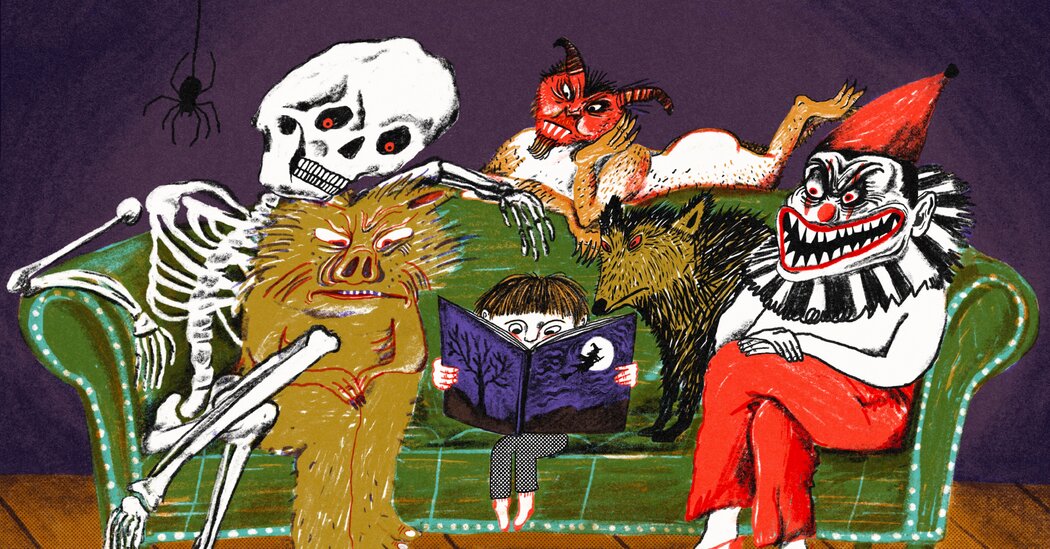When I was 6 or so, an illustration in “The Story of Babar” scared me so much I had to hide the book under a stack of sweaters at the bottom of my closet. Remember the Old Elephant King, after he’s eaten a bad mushroom? He goes from a normal-looking elephant to a mass of bilious greens; his crown lists sideways, his ears turn pencil-skinny, his eyes become slits and his forehead is suddenly as wrinkly as a walnut. (I have a fatal allergy to walnuts.) Even knowing the book was in my closet stressed me out — I imagined that, somehow, in the middle of the night the Old Elephant King could escape, so I periodically checked that it (he) was still there.
At 11, in my bunk at Camp Ramah, after lights-out, I obsessed over “The Wendigo” in Alvin Schwartz’s “Scary Stories to Tell in the Dark.” (A forest guide disappears in wintertime, leaving footsteps in the snow that grow longer and longer, and less and less human. The story does not have a happy ending.) The book’s black-and-white illustrations, by the great Stephen Gammell, who also illustrated its two sequels, are utterly unnerving — a mix of obfuscating cloudiness and razor-sharp edges; lumpy, grotesque figures and dripping shadows. Gammell’s art creeped out so many readers that for the trilogy’s 30th anniversary in 2011 it was replaced, though there was enough protest about the new illustrations being insufficiently horrifying that six years later the publisher issued a special boxed set with the original art.
As an adult, I’ve mostly avoided horror as a genre; real life is terrifying enough. And my own kids are resolutely anti-scariness.
As a toddler, Josie freaked out at “The Very Hungry Caterpillar,” perhaps alarmed by the creature’s endless, gnawing, unstoppable appetite. Dr. Seuss’ pale green pants with nobody inside them? She wanted nothing to do with those pants. (“I said, ‘I do not fear those pants/With nobody inside them.’/I said, and said, and said those words./I said them. But I lied them.”)
The worst of the worst was David Shannon’s 1998 picture book “A Bad Case of Stripes,” about a girl who is so worried about what others think of her, and so concerned about fitting in, that she takes on aspects of whatever is around her. Her skin becomes rainbow-striped after trying on 42 different outfits in hopes of impressing on her first day of school. When doctors suggest it might be some form of bacteria, she grows a colony of bacteria; when a veterinarian is consulted, she grows a long, furry tale; when a therapist tells her to relax and “become one” with her bedroom, she literally becomes her room. The psychedelic illustrations are pure electric Kool-Aid nightmare. In a sins-of-the-mothers sort of situation, Josie, age 6, hid the book. But her toddler sibling, Max, loved to look for it, dig it out and waddle after Josie, proffering it with wide, faux-innocent eyes and a maniacal-sweet smile as Josie screamed.
Josie got her revenge when Max, at 5 or so, attended a Halloween party at which older kids were watching the animated version of Neil Gaiman’s “Coraline.” After that, all Josie had to do was hold up a button and smile and Max would wail.
At bedtime, as the children got older, my attempts to read Roald Dahl’s “The Witches,” Edward Eager’s “Half Magic,” Deborah and James Howe’s “Bunnicula” and Tracey Baptiste’s “The Jumbies” aloud at bedtime all bombed. My kids did become avid readers, but goosebumps — and “Goosebumps” (by R.L. Stine) — were never on the menu.
And then came Lucy. My niece was born with goth sensibilities. From the time she could form sentences, she’d say, “I like creepy!” and “I like spooky!” When she was 7, as we sat by an estuary in Alameda and gazed at the water, she murmured, “I wonder how many bodies are in there.”
So it was a delight to look for just-frightening-enough picture books for her: “Creepy Carrots!,” “Creepy Pair of Underwear!” and “Creepy Crayon!” — all by Aaron Reynolds, all funny-freaky; “Lon Po Po,” by Ed Young, a “Little Red Riding Hood” retelling with the scariest-looking wolf in fairy-tale history; “Leo,” by Mac Barnett, with its cuddly yet altogether spooky illustrations by Christian Robinson; “Hershel and the Hanukkah Goblins,” by Eric Kimmel, with Trina Schart Hyman’s veiny-winged, moonlit, dreidel-playing monsters; “Just a Minute,” by Yuyi Morales, with a skeletal, sugar-skulled Señor Calavera paying Grandma Beetle a visit; “Goldfish Ghost,” by Lemony Snicket, with Lisa Brown’s blissfully upside-down-floating piscine phantom. Most of these were new to me.
Lucy opened up a whole haunted world I didn’t know as a child, or with my children. And as she got older, she recommended books to me.
I loved Arielle North Olson and Howard Schwartz’s “Ask the Bones: Scary Stories From Around the World.” (I will not, however, be reading her current fave, the Five Nights at Freddy’s graphic novel series.)
Ellen Handler Spitz, author of “The Brightening Glance: Imagination and Childhood,” believes that scary books can be helpers. “Children’s fears come from the ordinary processes of growing,” she said in an interview. “Getting teeth, learning to walk — which means you walk away from Mommy — falling down. What a scary book can do is frighten and stimulate a child to master the fear. That’s the greatest gift of literature: giving us a way to live our lives without having to suffer.”
Spitz told me that when she was a child she had the Little Golden Book version of “Walt Disney’s Pinocchio.” One spread depicted a whale opening its huge mouth to swallow the puppet. “I used to read it to myself, but carefully hold those two pages together so I didn’t have to see that mouth. Fears often relate to the body — mouths, being eaten — as well as the greatest interpersonal fear there is: the fear of abandonment. Life is going to bring scary experiences — moving to a new house, going to college, starting a new job — and these books can be a wonderful way of learning that you can handle it.”
I’m amused that at this late stage of the game, my 11-year-old niece is showing me that I, too, can handle it.
The post How I Stopped Worrying and Learned to Love the Macabre appeared first on New York Times.




